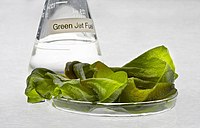
Photo from wikipedia
Abstract Hydrothermal Liquefaction is a thermochemical process that uses heat and pressure to convert biowastes into renewable biocrude oil, simultaneously generating both a metal and phosphorus rich solid phase and… Click to show full abstract
Abstract Hydrothermal Liquefaction is a thermochemical process that uses heat and pressure to convert biowastes into renewable biocrude oil, simultaneously generating both a metal and phosphorus rich solid phase and a nutrient rich aqueous phase. Eight types of food waste, all collected from a campus dining hall and grouped into lipid-rich, protein-rich, and carbohydrate-rich feedstocks, were processed with conditions ranging from 280-340oC and 10-60 min reaction time. The byproducts for the optimized oil yield conditions were analyzed to elucidate mechanisms by which compounds are concentrated in different phases through their characterization. The differences in elemental and biochemical composition among feedstocks demonstrate considerable gaps in understanding the expected characteristics as a result of several reaction parameters and how to best reuse the materials. This work additionally reviews considerations for subsequent anaerobic digestion and algae cultivation with respect to the nutrients and inhibitory contents of the Hydrothermal Liquefaction Aqueous Phase.
Journal Title: Bioresource Technology Reports
Year Published: 2020
Link to full text (if available)
Share on Social Media: Sign Up to like & get
recommendations!